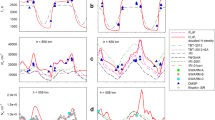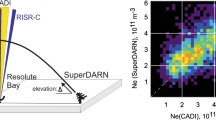Abstract
The ionosphere is an atmospheric region in which a large number of charged particles interact. Therefore, the production and loss mechanisms in this region play an important role in the modeling and interpretation of the ionosphere. In this study, the cross-section (CS) values, calculated by kinetic theory, were used to validate the International Reference Ionosphere (IRI) model at four different heights (210 km, 240 km, 340 km, and 410 km) on the equinox (March and September) and solstice (June and December) days in 2008 and 2015. The CS values were obtained by using both the temperatures of ions and electrons predicted in the IRI 2007, 2012, and 2016 versions, and the temperatures measured by the Kharkiv incoherent scatter radar (ISR). As a result of the calculation, the CS values in the solar minimum year (in 2008) were greater than those with moderate solar activity in the solar declining phase year (in 2015). The three versions of IRI show almost the same value in 2008. While these values are consistent with the values obtained from the ISR during the day, they are quite low at night. Validation of the model was carried out using Root Mean Square Error (RMSE) and Mean Absolute Percentage Error (MAPE) metrics. According to RMSE and MAPE values, it can be said that the predictions of all three versions of the IRI model are quite good. It can also be stated that the estimations of IRI-2016 are generally better than those of other versions of the IRI model. However, it is important to use ISR data to improve estimations of models at lower altitudes.








Similar content being viewed by others
References
Whitten, R., & Poppoff, I. (1964). Ion kinetics in the lower ionosphere. Journal of the Atmospheric Sciences, 21(2), 117–133.
Bernhardt, P., Park, C., & Banks, P. (1975). Depletion of the F2 region ionosphere and the protonosphere by the release of molecular hydrogen. Geophysical Research Letters, 2(8), 341–344.
Bruskin, L., Koen, M., & Sidorov, I. (1988). Modelling of neutral-gas releases into the earth’s ionosphere. Pure Applied Geophysics, 127(2–3), 415–446.
Rees, M. H. (1989). Physics and chemistry of the upper atmosphere (Vol. 1). Cambridge University Press.
Schunk, R., & Nagy, A. (2009). Ionospheres: Physics, plasma physics, and chemistry. Cambridge University Press.
Hierl, P. M., et al. (1997). Rate constants for the reactions of O+ with N2 and O2 as a function of temperature (300–1800 K). The Journal of Chemical Physics, 106(9), 3540–3544.
Yasar, M., & Canyilmaz, M. (2018). Investigation of chemical processes of O++ H2 (V= 0, J= 0) reaction using thermal variation in the ionosphere regions. Thermal Science, 22(1), S47–S53.
Yaşar, M., Atıcı, R., & Sağır, S. (2018). The change of the collision parameters of ‘O+ + N2 → NO+ + N’ reaction according to geomagnetic activity days in the ionosphere. MSU Journal of Science, 6(1), 529–532.
Karwasz, G. P. (2022). “Atoms” Special Issue (Electron Scattering in Gases—From Cross Sections to Plasma Modeling) (p. 54). MDPI: Atoms.
Carelli, F., Fedus, K., & Karwasz, G. (2021). Total cross sections for electron and positron scattering on molecules: In search of the dispersion relation. Atoms, 9(4), 97.
Modak, P., & Antony, B. (2021). Electron scattering from HNCO. The European Physical Journal D, 75, 1–9.
Sağir, S., Yaşar, M., & Atici, R. (2019). The Relationship between Dst, IMF-Bz and collision parameters for O++ N 2→ NO++ N reactive scattering in the ionosphere. Geomagnetism and Aeronomy, 59, 1003–1008.
Chernogor, L. F., et al. (2019) Physical processes in the ionosphere during the solar eclipse on March 20, 2015 over Kharkiv, Ukraine (49.6° N, 36.3° E). Journal of Atmospheric and Solar-Terrestrial Physics, 182, 1–9.
Bogomaz, O., Miroshnikov, A., & Domnin, I. (2017). Peculiarities of database for Kharkiv incoherent scatter radar. in 2017 International Conference on Information and Telecommunication Technologies and Radio Electronics (UkrMiCo). IEEE.
Zhang, X., et al. (2016). A novel framework for molecular characterization of atmospherically relevant organic compounds based on collision cross section and mass-to-charge ratio. Atmospheric Chemistry and Physics, 16(20), 12945–12959.
Liu, Z., Fang, H., Weng, L., Wang, S., Niu, J., & Meng, X. (2019). A comparison of ionosonde measured foF2 and IRI-2016 predictions over China. Advances in Space Research, 63(6), 1926–1936.
Bilitza, D. (2001). International reference ionosphere 2000. Radio Science, 36(2), 261–275.
Bilitza, D., & Reinisch, B. W. (2008). International reference ionosphere 2007: Improvements and new parameters. Advances in Space Research, 42(4), 599–609.
Bilitza, D., et al. (2014). The International Reference Ionosphere 2012—A model of international collaboration. Journal of Space Weather and Space Climate, 4, A07.
Bilitza, D., et al. (2017). International Reference Ionosphere 2016: From ionospheric climate to real-time weather predictions. Space Weather, 15(2), 418–429.
Bilitza, D., et al. (2022). The International Reference Ionosphere model: A review and description of an ionospheric benchmark. Reviews of Geophysics, 60(4), e2022RG000792.
Lewis, C. D. (1982). Industrial and business forecasting methods: A practical guide to exponential smoothing and curve fitting. Butterworth-Heinemann.
Acknowledgements
We thank the IRI model group for electron and ion temperature values. We also thank Mus Alparslan University for their support of this study.
Author information
Authors and Affiliations
Contributions
This study was carried out within the scope of the project numbered BAP-18-TBMY-4905-01 supported by Muş Alparslan University. The authors in Ukraine, L.E. and M.L. they are responsible for collecting and organizing data and interpreting results. Researchers at the Turkey leg of the project, M.Y., to carry out the statistical calculation using the data, S.S., the interpretation of the results obtained from the calculation result, S.K. interpretation of results, editing of data and R.A. is responsible for drawing the graphics, uploading the article and interpreting the results. All authors collaborated on the editing of the article.
Corresponding author
Ethics declarations
Conflict of interest
The authors declare that they have no competing interests.
Additional information
Publisher's Note
Springer Nature remains neutral with regard to jurisdictional claims in published maps and institutional affiliations.
Rights and permissions
Springer Nature or its licensor (e.g. a society or other partner) holds exclusive rights to this article under a publishing agreement with the author(s) or other rightsholder(s); author self-archiving of the accepted manuscript version of this article is solely governed by the terms of such publishing agreement and applicable law.
About this article
Cite this article
Yasar, M., Sagir, S., Emelyanov, L.Y. et al. Calculation of the Ionospheric Cross-Section with the Incoherent Scattering Radar and Its Comparison with the Predictions of the IRI Model. Wireless Pers Commun 132, 487–503 (2023). https://doi.org/10.1007/s11277-023-10619-6
Accepted:
Published:
Issue Date:
DOI: https://doi.org/10.1007/s11277-023-10619-6




